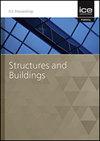Web slenderness effects on flexural behaviour of compound normal and high-strength steel beams
IF 1.4
4区 工程技术
Q3 CONSTRUCTION & BUILDING TECHNOLOGY
Proceedings of the Institution of Civil Engineers-Structures and Buildings
Pub Date : 2023-05-22
DOI:10.1680/jstbu.22.00113
引用次数: 0
Abstract
This paper discusses web slenderness effects on the flexural behaviour of epoxy adhesive-bonded compound normal and high-strength steel beams. The compound beams were simply supported and consisted of an I-section connected, on its top flange, to a channel section via an epoxy adhesive. A nonlinear 3D finite element modelling study has been performed using ABAQUS software for the analysis of the beams. The nonlinear finite element modelling was verified against tests on compound steel beams having different cross-sections. An extensive parametric study was carried out using the finite element modelling to study the effects of the change in web slenderness, cross-section geometries, beam lengths and steel strengths on the flexural behaviour of compound steel beams. The failure moments predicted from the finite element modelling were compared with the design moments predicted from the European code for steel beams in flexure. It is shown that the Code, generally, overestimated the design failure moments for most of the epoxy adhesive-bonded compound steel beams investigated in this study. In addition, reliability analysis was performed to assess the reliability of the design rules of the code. Generally, it is found that the European Code is unconservative and statistically unreliable for the epoxy adhesive-bonded compound beams investigated in this study.腹板长细对普通和高强度复合钢梁抗弯性能的影响
本文讨论了腹板长细对环氧胶粘剂粘结复合正高强钢梁抗弯性能的影响。复合梁是简单支撑的,由一个i型截面组成,在其顶部法兰上,通过环氧粘合剂连接到通道部分。利用ABAQUS软件对梁进行了非线性三维有限元建模研究。通过不同截面组合钢梁的试验验证了非线性有限元模型的正确性。利用有限元模型进行了广泛的参数化研究,以研究腹板长细比、横截面几何形状、梁长和钢强度变化对复合钢梁抗弯性能的影响。将有限元模型预测的破坏弯矩与欧洲规范中预测的设计弯矩进行了比较。结果表明,对于本研究研究的大多数环氧胶粘剂粘结复合钢梁,规范通常高估了设计破坏力矩。此外,还进行了可靠性分析,以评估规范设计规则的可靠性。一般来说,欧洲规范对于本研究中所研究的环氧胶粘剂粘结组合梁是不保守的,在统计上是不可靠的。
本文章由计算机程序翻译,如有差异,请以英文原文为准。
求助全文
约1分钟内获得全文
求助全文
来源期刊
CiteScore
3.40
自引率
6.20%
发文量
61
审稿时长
12 months
期刊介绍:
Structures and Buildings publishes peer-reviewed papers on the design and construction of civil engineering structures and the applied research associated with such activities. Topics include the design, strength, durability and behaviour of structural components and systems.
Topics covered: energy conservation, people movement within and around buildings, strength and durability of steel and concrete structural components, and the behaviour of building and bridge components and systems

 求助内容:
求助内容: 应助结果提醒方式:
应助结果提醒方式:


